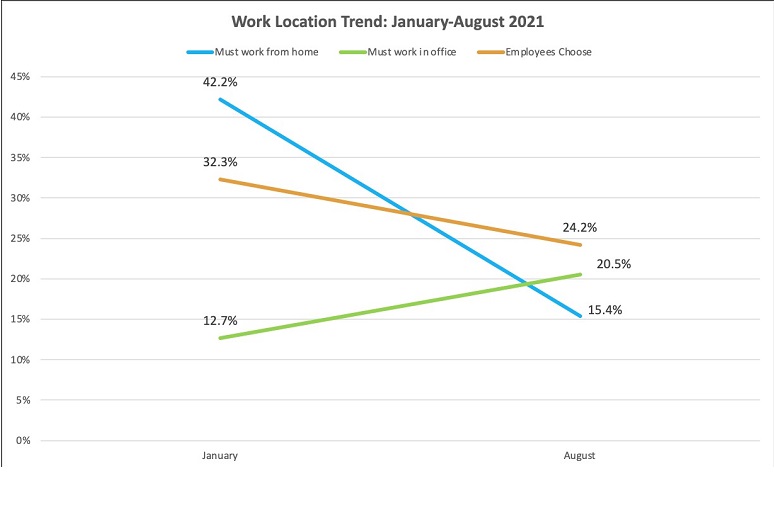Metrigy’s recently published Unified Communications Management and End-points: 2021-22 study of nearly 400 organizations found that the office is in a state of flux, with just over 15% of companies now fully work-from-home. Of the rest, about 21% require a return to the office, 24% provide employees with a choice of work location, and 38% base work location on the role. From January to August of 2021, we saw a significant trend toward returning to the office, often to the dismay of employees who prefer work-from-home flexibility (see graphic above).
As companies navigate a return to the office, often they’re rethinking both the purpose of the office and the physical office configuration. We noted that just 62% expect offices to be used the same way as in the past, as a place for individual work and meetings. Almost 19% see the office only as a meeting place, while 16% see it as primarily a place of individual work, with meetings occurring online. Just 23% expect that employees will fully embrace a return to meeting in conference rooms.
Many companies continue to make office adjustments to support these new ways of working. But are primarily focusing on limiting capacity or creating physical barriers between employees, either through plexiglass or enclosed workspaces. Absent a cohesive strategy, and organizations risk misaligning the needs of employees with their facility and IT plans.
Today we find that facilities, HR, and IT often overlap in ownership of office design. HR’s primary goal is to create a safe environment that fosters community and culture. Facilities want to maximize workspace efficiency and minimize cost. IT typically focuses on enabling enhanced collaboration capabilities through high-quality video and audio endpoints at the desk and in meeting spaces. In fewer than 5% of companies, there’s a committee composed of all three organizations to ensure coordination. Instead, the majority have different owners for different parts of the workspace.
Absent coordination exists the potential for conflict. Facilities teams may covet a return to open office designs that minimize available space per person to reduce real estate costs. HR may want to embrace office designs that foster employee engagement. And IT may still be of the old mindset that individual work happens at desks, and collaboration happens in meeting rooms. All these goals may conflict with individual employees who, in some cases, due to COVID or other concerns, prefer to stay at their desks and physically distance themselves from their coworkers.
A successful strategy includes the following three components:
- Understand why employees are returning to the office. Is it to escape clutter and distractions at home? To foster better in-person collaboration and community building, or to access applications and systems that don’t work as well at home? Or is it simply a management mandate?
- Understand how employees prefer to work in the office. Some will prefer to return to a meeting in meeting rooms, while others desire to attend meetings virtually from their desks.
- Coordinate planning for facilities, HR, and IT. Doing so ensures that the office evolution enables collaboration and culture, optimizes floor space, and equips employees with the tools they need to successfully engage with one another, both in the office virtually.
A successful office evolution strategy starts with identifying key business and employee requirements and aligns facilities, HR, and IT on a common path to meet them. Ensure that these three groups work together to avoid conflict as you develop and implement your return-to-the-office strategy.






